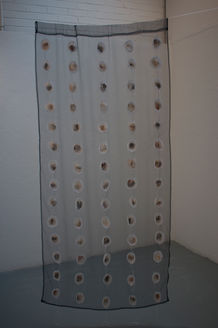top of page

Bianca Hendicott ARTIST
Self Portrait : My DNA and doilies
Self Portrait DNA and Doilies (mixed media) 2018
This work evolved out of an observation of the painterly nature and tones of makeup removal pads. The connotations here are the idea of DNA blending with makeup and forming a ‘real’ self-portrait blended with the ‘fake’ mask of cosmetics. Make up itself is also a ritual which can be both comforting and deceiving. It can conflict with identity and objectify the individual, yet in this process it becomes more of a cleansing ritual and a creative act that defies fetishisation or‘dehumanisation’. (LePage,A .2018)xix The objects are actually quite fragile to work with because of the cotton wool but are kept together by crochet which is a symbol again of the
power of ‘female’ craft in the creation of identity and its preservation. Fragility is also an element of identity and in particular female identity. This aspect, combined with the physicality or painterly quality of the works when grouped together creates a fuller portrait of the ‘sitter’ who becomes active in the wiping away of the make-up. These recycled ‘craft works’, like crochet, is a skill passed down from one generation of females to the next - much like genetic traits – and much like the layering and ordering of the pieces on the fabric. This composition was also inspired by Eva Hesse’s circle drawings/paintings in rows which added a sense of order whilst individually each piece remains strange and mysterious – unusual feminine objects with overlapping ‘tendrils’ of uncut knotted crochet threads. In fact using exposed thread, dangling or intertwined in my work gives a sense of the overlaying and interconnectivity of culture and identity. It also speaks of threads in DNA, ancestry, communication and thought. So why crochet a doily?
The doily has really captivated me, often stereotyped as dust collectors or the product of bored or fussy housewives, there is something intrinsically beautiful in the work which often resembles textile geometry, patterns and mandalas. For women who were excluded from the patriarchal art world, these small works often become vehicles for artistic expression and even escapism. Ironically though the doily may have got its name from a male cloth merchant named ‘Doyley’ who made fancy ‘doily napkins’. In the 1900s they had become so popular that almost every home had one and they became symbols of domestic etiquette and fine home furnishings. With an increase in media, doilies became more popular as free patterns were featured and attracted housewives who were interested in entertainment and craft. However, later feminist movements began to see the importance of these ‘feminine craft skills’ as carefully created aesthetic constructs. In 1975 The Centre for the History of American Needlework put up an exhibition they called ‘The Art of the Doily’ in New York. Doilies and textile art thus became symbols of ‘sisterhood’, creativity, and female strength. In fact, many women I know, now in their 80s, continue to find joy, meditation, and creative escape in the creation of these works. I have yet to find a study done on the mental health benefits of these activities, but I am certain that the problem solving involved in pattern creation and counting would benefit an aging brain. They also offer a delicate contrast to the hard aspects of housework where the hands are often employed in tasks such as washing and scrubbing (alleviated in modern society to some extent through technology). Furthermore, because doilies are associated with the domestic, they also have accompanying narratives of individual family lives and in a sense ‘absorb’ the domestic atmosphere of a place and its people. They take on smells and spills and the cotton itself often discolours with age. Today, we mostly associate doilies with grandmothers, charity shops and vintage / retro vibes. As they recede into a nostalgic past it would be wonderful to see more of them escape the side table and take their rightful place on gallery and museum walls.
bottom of page







